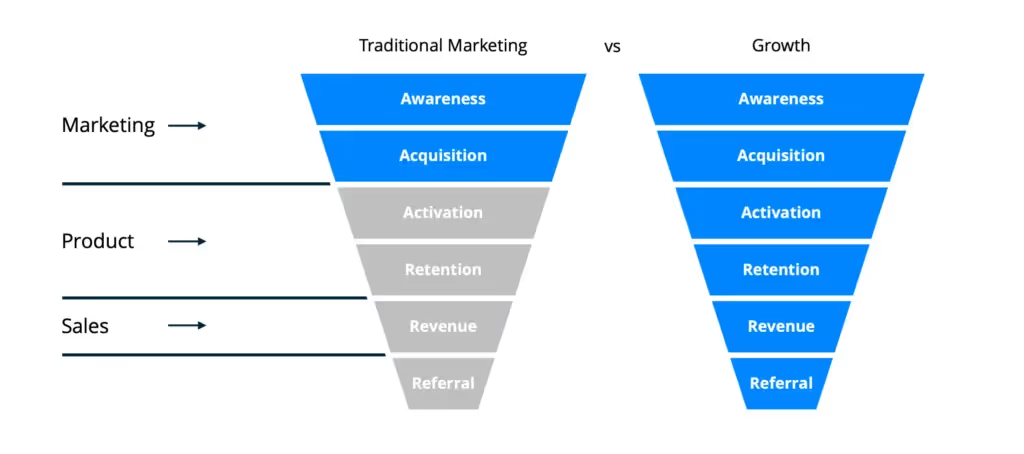How To Leverage Growth Marketing
Traditional marketing is where brands broadcast a one-size-fits-all marketing message describing the product’s features. It is expensive, broad, and doesn’t consider the unique requirements of the customer.
This doesn’t work well for budding businesses that are targeting a particular niche and have a limited marketing budget.
Enter growth marketing.
Growth marketing focuses on sending personalized customer-centric messages to the target audience explaining how the product will give them the value they are looking for.
In this article, you’ll learn what makes growth marketing unique, its strategy and characteristics, and how you can leverage it.
Growth Marketing Vs. Regular Marketing
Growth marketing attracts prospects, keeps them hooked, and turns them into loyal buyers. With techniques such as content marketing and lead nurturing, customers are nudged through the funnel until they make a purchase.
Various marketing channels are auto-optimized through the latest tools and data-backed processes for sustainable growth. The primary advantage of growth marketing is that it nurtures customer relationships and increases your average customer lifetime value.
Traditional marketing approaches include ideation of marketing operations, publishing the ad copy and design, implementing Call-To-Actions (CTAs), outlining the ad spend for the campaign, and so on.
All these efforts follow a traditional “set it and forget it” strategy. This strategy is great for increasing brand awareness by focusing on the top of the sales funnel.
The image below highlights the difference between traditional and growth marketing.

What a Growth Marketing Strategy Includes
Market Penetration
Growth marketers exclusively focus on the niche where you offer products/services or look for potential customers in your competitors' niche to penetrate the market better.
This growth hacking technique pushes brands to look for differentiators. Here, growth marketers answer two specific questions:
- What sets you apart from your competition?
- What are the specific areas you are better than your rivals?
Strategic Collaborations and Partnerships
Growth marketing teams facilitate rapid growth by finding and teaming up with other brands that offer products your target audience uses — for instance, telecom providers partnering with smartphone manufacturers.
Apart from keeping customer acquisition costs low, this strategy could get you lots of new customers and result in sustainable growth. Sometimes, you might have to create new products or services to form a partnership.
Market Development
This strategy involves running growth marketing campaigns where you advertise the products or services to new markets to facilitate demand generation. It is done in two ways:
- Targeting new niches and buyer personas.
- Moving to new geographic regions.
Product Development
Your product development growth strategy has to be tailored to your brand’s specific needs. To attain rapid growth, you should diversify your marketing efforts to find creative solutions in the following ways:
- Product Updates. Build on what you have (this is also great for customer retention).
- New Products. A great way to enter new markets and target different user personas.
Characteristics of a Growth Marketing Strategy
Data-driven
Before growth marketers invest in a new marketing tactic aiming for rapid growth, the idea has to be backed by data. As growth marketing tactics involve taking risks, intuitions and “do this because competitors are too” have no place.
Read: “How to Create a Successful Growth Marketing Strategy.”
Product Focused
Your business needs to consistently improve its product to remain competitive in the market. Whether it is adding more features or functionalities, your product needs to evolve with the changing needs of your target audience.
Growth marketing facilitates this by collecting data that can guide this product development and keep your target audience updated about the values you offer.
Limited fear of failure
Apart from being data-driven, the high success rate of growth marketing can be attributed to the diversification of efforts. With multiple marketing strategies at play at once, the best growth marketers keep a close eye on the numbers and scale up the efforts that have the highest marketing ROI.
Storytelling
Considering our endless appetites for stories, growth marketers use a story where a person with similar problems to the target audience gets their problem solved with their product. This makes the brand’s message more realistic and relatable, motivating more prospects to make a purchase.
Retargeting
Retargeting reminds your website visitors, prospects, leads, and customers about the value your product offers. This also keeps the customer acquisition costs low.
Should You Hire a Growth Hacker or Outsource Growth Marketing to an Agency?
Having an in-house growth marketer has the following pros:
- They will be familiar with your product and processes completely.
- 100% dedication towards your brand growth.
- You can gain a lot of insights into your industry.
However, it is challenging for the following reasons:
- It's expensive to hire new professionals, get new tools, and set up new growth marketing strategies.
- After some time, they could run out of ideas by falling into a "creative rut".
- You still have to pay your growth marketing team even if you pause your strategy.
Growing brands with a limited budget risk a lot in this scenario.
In these instances, outsourcing growth marketing to an established agency such as Matter Made is ideal because:
- You get experienced, accountable professionals.
- It’s cost-efficient; pay until you are leveraging their services.
- You will be kept in the loop at every stage through timely reports.
- You can reinvest the saved resources elsewhere.
- You get expertise from successful growth marketers.
Growth Hacking, Demand Generation, and Matter Made
Matter Made has helped product-led companies like Dropbox and Loom achieve hypergrowth through demand generation, product-led growth, and bespoke growth strategies.
Our seasoned marketing team can help your brand achieve similar results.
Interested in knowing what a growth marketing strategy brings to the table for your brand? Let’s talk.












